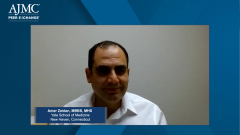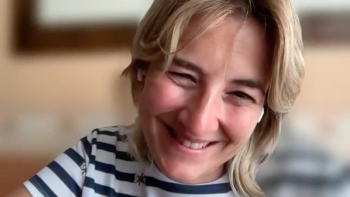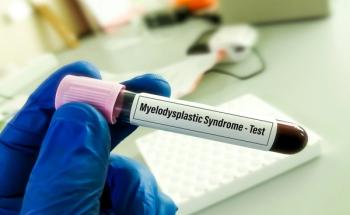
Goals of Therapy for Patients With Myelodysplastic Syndromes
Panelists share insight on therapeutic goals when treating patients with myelodysplastic syndromes.
Episodes in this series

Transcript:
Bruce Feinberg, DO: Amer, when we’re initiating, whether it’s ESAs [erythropoietin-stimulating agents] or transfusions, are we treating the number, or are we treating the symptom complex? I know the answer is going be, “We’re treating everything,” but there are patients whose hemoglobin will be higher. But as Tracey said, they don’t feel the bump. How are you approaching that? If their hemoglobin is OK, is it that we’ve done what we can do? Or are we thinking of the disease differently? Are we thinking that there’s a manifestation beyond just what it’s doing to diminish the level of a blood cell?
Amer Zeidan, MBBS, MHS: That’s a fantastic question. The short answer in any cancer is that the goal is to make the patient live longer or better, or ideally both. It’s never about treating a specific number. In some patients, higher hemoglobin does correlate with better quality of life and better symptoms, but that doesn’t happen all the time. There are patients who don’t get that bump, whether from treatment or transfusions.
But at the same time, there are certain hemoglobin levels that if you go below, we feel uncomfortable. We don’t know exactly what that level is, because there’s a lot of debate about at what level patients should be transfused, even if they have no symptoms whatsoever, because it can impair their organ function. It depends on the practice, but most people won’t let the patient go below a hemoglobin of 7 g/dL without transfusing them. This could vary to 7 and a half or 8 g/dL. In some situations, like in patients who have cardiac problems or coronary artery disease, that can even be up to 9 g/dL. It depends on the individual patient, but the short answer is that we never go by the number alone. It’s a very bad idea to go by a specific threshold without thinking about the patient as a whole.
Bruce Feinberg, DO: Tracey, I’m curious. We have a lot of patients and the communication with them that’s coming from the hematologist is about the number. Every time they come in, it’s about the hemoglobin. “Your hemoglobin is this, your hemoglobin is that.” Sometimes the patient feels like crap, but the hemoglobin is OK. Or it’s in a place where they don’t need to be transfused, or they’re trying to be cautious about overtransfusing. How is that communicated when we talk about the disease to this general population of patients? What should they be asking their doctors about?
Tracey Iraca: I’m happy to hear Amer say that you don’t look at the number, but a lot of doctors still do. We’ve gotten multiple complaints from patients saying, “My doctor won’t transfuse me unless I’m below 8 g/dL, but I feel awful at 9 g/dL, and no one’s listening to my symptoms.” That can be a real challenge to get that understanding of the patient’s quality of life. Everyone’s different. Maybe at 9 g/dL, they really do need a transfusion.
Ryan Haumschild, PharmD, MS, MBA: To your point, patient-reported outcomes and quality of life are important. Especially as we and IDNs [integrated delivery networks] are insuring our own patient population, we’re treating our own employees, let alone patients in the community. You have to reduce some of that fatigue. You have to make them feel better so they can function in their activities of daily living. We see in this disease state that if not managed, or if you’re just managing a number, patients can technically be OK, but not functioning well at all. That’s one of the biggest issues within this disease. How do you make sure patients are able to function with that fatigue? There are all of those things that are going on, even if their number may technically meet the number of transfusions not appropriate for an additional treatment, or that may be more high cost. Or at the same time, maybe a provider’s withholding red blood cell treatment because they’re technically OK. We want to focus on improving that and improving the quality of life for the patient.
Bruce Feinberg, DO: Amer, what else is being done for that patient? In a cancer situation, it might be discussions about physical therapy. What more can we be doing? Things like attention to diet and exercise might help them feel better in general, and you hope that it’s a combination of factors. And then there’s the depression aspect, which may be clinical depression that’s diagnosable, or the depressed effect of having to live with a chronic disabling disease that may even be life-threatening for them. Amer, at an institution like Yale University, in that team approach, is there more being done or offered? Or is it like, “We’re just going to maintain your blood cancer as best we can?” That’s usually what is the determination of the symptoms, and if this isn’t effective, we’ll move on to the next therapy.
Amer Zeidan, MBBS, MHS: That’s an important observation. This is where what I would call the art of medicine comes in, because it differs between patients. One of the most challenging aspects in MDS [myelodysplastic syndromes] is that the fatigue, which tends to be a predominant problem in MDS, is many times disconnected from the degree of anemia. It’s a little puzzling to patients, because as the others were saying, many times they’d look at their hemoglobin and they’re feeling very poorly, but their hemoglobin is 9 and a half g/dL. It’s important to realize that even if you transfuse these patients, many times, they aren’t going to feel much better.
The way I approach this is, if someone is feeling poorly and their hemoglobin is 8 and a half or 9 g/dL, I’ll give them a blood transfusion and then see how they feel. If they aren’t getting any benefit in terms of how they feel, I’m not sure I would transfuse them, because each time you’re giving someone a transfusion, it comes with some risks. Although it’s a very low risk of infection, there’s iron overload and other things. Also, we don’t improve survival when we give transfusions. If you’re not improving how the patient feels with their quality of life, you have to think hard about whether you want to give a transfusion in that situation. They are the most challenging patients to treat, those who have lower-risk MDS and significant fatigue, but their hemoglobin is in the range of 9 to 10 g/dL, and they don’t benefit or feel better with transfusions. Those are very challenging patients. I tell them that there could be things in their lifestyle that they could do. “Try to do some exercise, try to sleep well, try to improve your diet.” Sometimes these things can help, but it’s a real therapeutic dilemma when the fatigue has no other explanation.
Bruce Feinberg, DO: Ryan, is there that team approach that’s brought to bear? Are those resources available?
Ryan Haumschild, PharmD, MS, MBA: Yes. With MDS, it’s starting to become a team-based disease state for us. I don’t want to say it was too niche at the time, but we had a few providers who really focused on it. But as you start to look at it, with patients coming in all the time, there’s social work and they have to travel from these remote places. Sometimes you might have a farmer who’s trying to get ready for a harvest and feels exhausted and their livelihood depends on this. Getting them involved with social work and in physical therapy and then titrating in some of the blood transfusions, like Amer mentioned, can make a huge difference. Team-based care is there, and then following up and monitoring them via telehealth appointments to hear how their symptoms are is another important piece so that we’re not bringing them back all the time outside of the necessary transfusions.
Bruce Feinberg, DO: Tracey, when we think about that team approach—you talked about the centers of excellence approach that you provide in terms of making sure patients are getting all the resources available—do you consider that team approach when you’re starting to identify a center of excellence?
Tracey Iraca: Absolutely. The centers of excellence are identified on our website by center, but also with a PI [principal investigator] associated. But we’re now including the nurses, social workers, nutritionists, all of the people at that center who the patient with MDS and their family might come in contact with to help in the big picture. We have an international nurse leadership board that’s now focusing on a project called Fit for Treatment, doing their best to have a more well-rounded approach to keep a patient fit in general so that they can withstand some of the adverse effects and toxicities that come with the necessary treatment.
Bruce Feinberg, DO: That’s great. That almost speaks to prehabilitation, which has gotten to be huge for orthopedics. The recovery time after a hip or a knee procedure is so much shorter when you go into that procedure already reasonably conditioned, where the weight-bearing leg is going to be able to bear the weight of the body. That’s great that you’re starting to look at those things. It’s invaluable, especially in the low-risk patient population, where they’ve got the time to be worked into those kinds of lifestyle changes.
Transcript edited for clarity.
Newsletter
Stay ahead of policy, cost, and value—subscribe to AJMC for expert insights at the intersection of clinical care and health economics.











